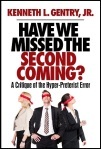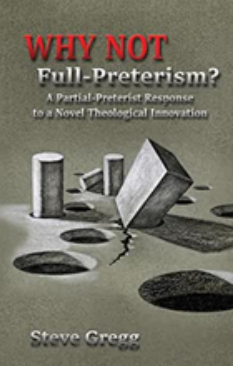PAUL’S CONCERN IN 1 CORINTHIANS 15
 PMW 2023-049 by Kenneth L. Gentry, Jr.
PMW 2023-049 by Kenneth L. Gentry, Jr.
A QUESTION ABOUT THE FIRST FRUITS
A reader wrote a question in response to my article: “Spiritual Resurrection at Death?” (PMW 2023-042). In that article I argued for the universal, historic doctrinal position of orthodox Christianity that our eschatological resurrection will be material/physical. There I pointed out that the “first fruit” resurrection of Christ (1 Cor. 15:20, 23) demands that the final resurrection will be of the same kind as Christ’s, which was material/physical (Luke 24:38–39; John 2:19–21; 20:19–20, 25–27).
In response, my reader wrote: “It seems that could make for an extremely long germination period. How does one decide whether the similarity of the harvest to the first fruit, i.e. Christ’s resurrection, is in nature and/or in timing?”
MY ANSWER ABOUT THE FIRST FRUITS
The first concern. I would point out in reference to his first concern: you must remember that this is a metaphor, it is a figurative use of an historical agricultural / ritual practice from ancient Israel. It is not teaching us about literal wheat seeds and the ultimate wheat harvest from those seeds. Such a period from germination to harvest literally takes only four months. Paul is not arguing that four months after Jesus was resurrected the eschatological resurrection occurred. Nor does this image deal with how long the ancient Jew must hold on to his first fruits before he offers them to the Lord. Nor should we be concerned that he is speaking of a literal wheat harvest that is taking over 2000 years.
 Why I Left Full-Preterism (by Samuel M. Frost)
Why I Left Full-Preterism (by Samuel M. Frost)
Former leader in Full Preterist movement, Samuel M. Frost, gives his testimony and theological reasoning as to why he left the heretical movement. Good warning to others tempted to leave orthodox Christianity.
See more study materials at: KennethGentry.com
We must understand that what seems long to us is not long to God, with whom a day is as a thousand years. We should not be like Eve when God promised a Redeemer to come (Gen. 3:15). She believed that her first child was the Redeemer she was to expect (Gen. 4:1). Yet thousands of years passed before God — in his own good timing — sent the Redeemer in the fullness of time (Gal. 4:4).
The second concern. Regarding whether Paul is dealing with the (1) nature of the resurrection or its (2) timing, the answer is actually quite simple. And it shows why virtually all Bible-believing scholars speak of the first fruits as both temporal and factual, but with Paul’s main interest on the factual, i.e., physical, nature of the resurrection.
Clearly Paul’s primary concern lies in the factual nature of the physical resurrection. Notice how he introduces this very chapter: his deep interest in the physical nature of the resurrection prompted him to write this lengthy chapter (1 Cor. 15). He opens with the declaration that Christ was buried and that his physical body was raised from the dead (1 Cor. 15:4) and was seen by so many (vv. 5–8). Then he directly challenges and castigates those who say there is no resurrection of the dead (vv. 12–19). He shows these proto-gnostics the folly of their view by his arguments: “If the dead are not raised at all” (v. 29), “If the dead are not raised” (v. 32).
After this he mentions Christ as the first fruits, which speaks both temporally (he is the first fruits) and factually: he explains that the resurrection of Christ in the first century will ultimately lead to the resurrection of his people at the end of the last century. He notes that these two resurrection phenomena will occur, but “each in his own order” (v. 23). This “each”-statement refers to the two events in view: the resurrection of Christ himself (who is the first fruits) and then the resurrection of all of Christ’s people (who will all simultaneously be corporately raised from the dead): “those who are asleep”; vv. 20–23, 52–53; cp. John 5:28–29; Acts 24:15).
After all, Paul is rebutting those who deny the resurrection itself (see above). And he tells us that he is answering two burning challenges that these proto-gnostics present: “But someone will say, [1] ‘How are the dead raised? And [2] with what kind of body do they come?” Their interest is not in the timing of the event but in its factuality, i.e., its physical occurrence — because they don’t believe a physical resurrection will happen at all (vv. 1–19). Though Paul will bring in the temporal angle, it will be for the purpose of demonstrating that the eschatological resurrection will not occur until “the end” (vv. 24, 52). Thus, they cannot say at any time before it occurs that it is already passed (e.g., 2 Tim. 2:16–18).
Have We Missed the Second Coming:
A Critique of the Hyper-preterist Error
by Ken Gentry
This book offers a brief introduction, summary, and critique of Hyper-preterism. Don’t let your church and Christian friends be blindfolded to this new error. To be forewarned is to be forearmed.
For more Christian educational materials: www.KennethGentry.com
Thus, Christ is both the (1) first one temporally to experience (2) the actual eschatological resurrection. The future, corporate eschatological resurrection, will not be like Lazarus’ resurrection — or any previous historical resurrection. Rather it is the ultimate resurrection that involves the body rising from death as imperishable, glorious, powerful, and Spirit-dominated (vv. 42–44, 50, 52–53). Christ’s resurrection occurs first, then later his people will be resurrected in the same way as his, since his is the first fruit of theirs. Just because it hasn’t happened yet, does not mean it will not happen. But when it does happen “the end” comes.
The word “now” (Gk. nun) in 1 Corinthians 15:20 does not necessarily present a solely temporal concern. “But now Christ has been raised from the dead, the first fruits of those who are asleep.” For as the BAGD Lexicon notes: this word as found in this phrase (nun de, “but now”) “not infreq[uently] serves to contrast the real state of affairs with the statement made in an unreal conditional clause.” Here it means “as a matter of fact,” as it introduces the real situation. Though the proto-gnostics of Paul’s day deny the resurrection of the body, as a matter of fact the body will be resurrected.
When Paul writes: “Now I say this, brethren, that flesh and blood cannot inherit the kingdom of God; nor does the perishable inherit the imperishable,” he is not saying the resurrection body will not be physical. Rather he is saying the resurrection body will not be frail and sinful. It will no longer, therefore, be subject to death (vv. 54–55). Again timing is not the issue.
Neither Paul nor the proto-gnostics is concerned with the timing of the eschatological resurrection. Thus, Paul deals at length with the kind of body that is raised (vv. 29, 35): it will be imperishable, glorious, powerful, and Spirit-dominated (vv. 42–49, 50–54). The body that is sown is not the body which is to be. That is, the body that dies is sown as perishable, inglorious, weak, and “soulish” (psuchikos), i.e., a body subject to animal needs (vv. 44, 50). But it is not raised as such. Rather it is raised as just mentioned: imperishable, glorious, powerful, and Spirit-dominated (a pneumatikos-body).
Consequently, the first fruit is a pledge of more to come. Verse 20 involves a temporal logic as well as a representative logic (representation is clearly an issue here in this chapter in that Paul speaks of the first Adam and the last Adam). And the representative logic is primary in Paul’s mind because of the troublesome proto-gnostics denying the physical resurrection altogether. Christ’s physical resurrection represents the physical resurrection of believers (Paul is not here concerned with the resurrection of unbelievers, so he does not mention them).
Why Not Full-Preterism? by Steve Gregg
This work exposes some of the key flaws in Hyperpreterism by someone who has formally debated them. Much insightful material for those who might be tempted to forsake historic Christian orthodoxy.
For more Christian educational materials: www.KennethGentry.com

THE TWO AGES AND OLIVET (advertisement)
I am currently researching a study of the Two-Age structure of redemptive history. My starting point is based on the disciples’ questions to Jesus in Matthew 24:3. Much confusion reigns among those unacquainted with the Two-Age analysis of history, which was promoted by Jesus (Matt. 12:32; Mark 10:29-30) and by Paul (Gal. 1:4; Eph. 1:21). The Two Ages are not the old covenant and the new covenant, but world history since the fall and the consummate order following the Second Coming and the Final Judgment.
If you would like to support me in my research, I invite you to consider giving a tax-deductible contribution to my research and writing ministry: GoodBirth Ministries. Your help is much appreciated!
Kenneth L. Gentry Jr.'s Blog
- Kenneth L. Gentry Jr.'s profile
- 85 followers



